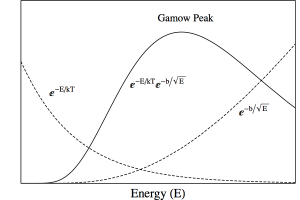Post
The Sun’s Magic
10 September 2012
Suppose I put a plastic cup on a table, and put a ping pong ball beside the cup. Then suppose I asked you to put the ball in the cup without touching either the ball or the cup. You might suggest moving the table or some such “out of the box” trick, but I don’t allow that. You might then say what I ask is impossible, and for the cup and ball you’d be right. On the scale of atoms and nuclei, however, it isn’t impossible. In fact it happens all the time in the core of our sun.
Atoms and nuclei are not governed by the familiar rules of Newton, but by the rules of quantum mechanics. Quantum mechanics can be a bit hard to wrap your head around, but one of the central principles is that you can never be entirely certain of things. If you want to know where an atom is, or what its energy is, you can never get an exact measurement. This “fuzziness” factor leads to a number of strange effects, of which one is quantum tunneling.
To use our ball and cup analogy, it would be as if the ball just happened to find itself inside the cup by chance. One moment the ball is outside the cup, and the next moment it is inside the cup. It is as if the ball “tunneled” into the wall of the cup, hence the name quantum tunneling. For the ball and cup this is impossible, but for the nuclei of atoms it is possible. This quantum tunneling effect is necessary for the sun to be a star.
The sun produces heat and light by fusing atoms. For example, hydrogen nuclei are slammed together so hard that they stick and produce helium atoms. The problem is that most of the hydrogen atoms in the sun’s core don’t have enough energy to stick together. To do that they have to overcome the repulsion of their positive charges, and they generally don’t have enough energy. To use our analogy, the ball is outside the cup, and it doesn’t have the energy climb up over the rim to get in the cup.
 BK
BKWith quantum tunneling, however, the nuclei can cheat. They have enough energy to get relatively close to each other, and then they have a chance of tunneling through the remaining barrier to stick together. This window of opportunity is known as the Gamow peak, and it is a product of how much extra energy it needs and the odds of it quantum tunneling. Because of the Gamow peak, the nuclei in the sun can fuse despite the fact that they don’t have enough energy to fuse on their own. Sometimes nature says “close enough” and gives them a bye. Without quantum tunneling, the sun wouldn’t be able to fuse nuclei in its core in any significant amount, which would mean it couldn’t be a star.
The fact that our sun is a star might seem magical, but it’s really just quantum mechanical.